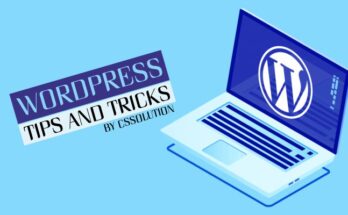In today’s fast-paced digital landscape, website performance is crucial for both user experience and search engine rankings. If you’re using WordPress, you’re in good company, as it powers over 40% of the web. However, to fully leverage its capabilities, you must optimize your site for speed and efficiency. Here are some essential tips and tricks to boost your WordPress website’s performance.
1. Choose a High-Performance Hosting Provider
The foundation of a fast WordPress site starts with your hosting provider. Opt for managed WordPress hosting providers like WP Engine, SiteGround, or Kinsta. These services offer optimized environments specifically for WordPress, ensuring faster load times, better security, and robust support.
2. Use a Lightweight Theme
Your theme significantly impacts your site’s performance. Choose a lightweight, well-coded theme like GeneratePress, Astra, or the default Twenty Twenty-One. Avoid themes loaded with unnecessary features or complex design elements that can slow down your site.
3. Optimize Images
Images are often the largest files on a web page, making image optimization critical for performance. Use tools like TinyPNG or ShortPixel to compress images without losing quality. Additionally, consider using the WebP format, which provides superior compression.
4. Implement Caching
Caching reduces the load on your server by storing static versions of your pages. Plugins like W3 Total Cache, WP Super Cache, and WP Rocket can dramatically improve load times. They handle tasks such as browser caching, page caching, and GZIP compression.
5. Use a Content Delivery Network (CDN)
A CDN stores copies of your site’s static files on servers around the world. This reduces latency by serving content from a location closer to the user. Popular CDN services include Cloudflare, Amazon CloudFront, and MaxCDN. By integrating a CDN, you ensure faster load times and improved user experience globally.
6. Minimize and Combine Files
Minification involves removing unnecessary characters from CSS, JavaScript, and HTML files without changing their functionality. Plugins like Autoptimize and Fast Velocity Minify can automate this process. Additionally, combining files reduces the number of HTTP requests, further speeding up your site.
7. Utilize Lazy Loading
Slow loading delays the loading of images and videos until they are needed. This make less initial load times & bandwidth usage. Plugins like a3 Lazy Load or Lazy Load by WP Rocket can easily implement this feature on your WordPress site.
8. Optimize Your Database
Over time, your WordPress database accumulates clutter from revisions, spam comments, and transient options. Regularly cleaning and optimizing your database can improve site performance. Use plugins like WP-Optimize or Advanced Database Cleaner to maintain a lean database.
9. Limit Plugin Usage
While plugins add functionality to your site, using too many can slow it down. Regularly audit your plugins and deactivate or delete those that are unnecessary. Ensure the remaining plugins are well-coded and regularly updated.
10. Enable GZIP Compression
GZIP compression reduces the size of your files, making them faster to load. Most caching plugins offer GZIP compression options. Alternatively, you can enable it manually by adding a few lines of code to your .htaccess file.
11. Regularly Update WordPress
Keeping WordPress core, themes, and plugins updated is essential for performance and security. Updates always include performance improvements and bug solved. Enable automatic updates or regularly check for updates through your WordPress dashboard.
12. Monitor and Analyze Performance
Regularly monitor your site’s performance to identify and resolve issues promptly. Tools like Google PageSpeed Insights, GTmetrix, and Pingdom provide detailed reports and suggestions for improvement. Use these insights to make data-driven decisions for optimizing your site.
13. Optimize External Scripts
External scripts, such as ads, fonts, or embedded content, can slow down your site. Limit the use of external scripts and load them asynchronously or defer them when possible. For example, you can load Google Fonts using the display=swap parameter to improve performance.
14. Leverage Browser Caching
Browser caching stores static files locally in the user’s browser, reducing the need to download them again on subsequent visits. Configure browser caching by adding appropriate headers in your .htaccess file or using a caching plugin.
15. Implement AMP (Accelerated Mobile Pages)
AMP is an open-source project that helps create fast-loading mobile pages. Applying AMP can remarkably make better mobile performance & user experience. Use plugins like AMP for WP or the official AMP plugin to integrate AMP into your WordPress site.
Conclusion
Optimizing your WordPress site for performance is an ongoing process that requires attention to detail and regular maintenance. By following these tips and tricks, you can ensure your website is fast, efficient, and provides an excellent user experience. Remember, a faster site not only improves user satisfaction but also boosts your search engine rankings, driving more traffic and success to your online presence. Go ahead optimizing today & see the difference it creates!





Your insights are always so valuable.